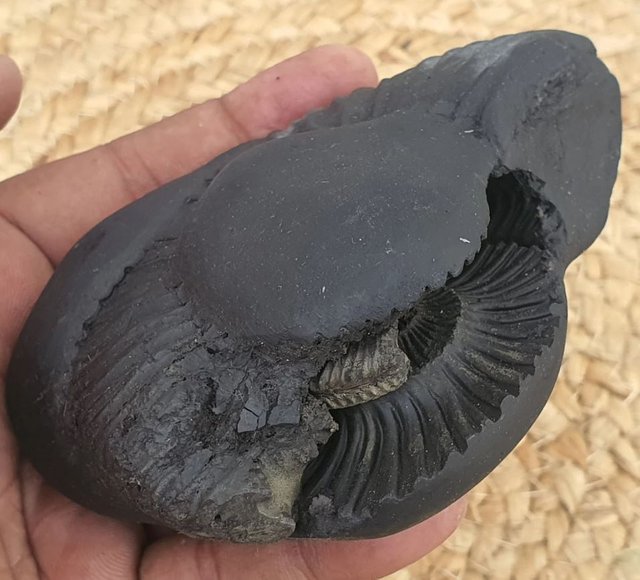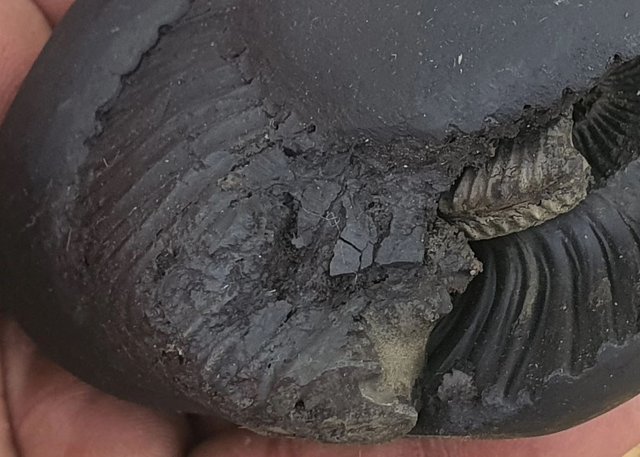It is the position of modern science that ammonites are fossils. However, the history of science labeling geological features as fossils has the example of the Eozoon canadense found in Canada that was initially believed to be a gigantic Foraminifera before it was recognized to be geological in origin. This challenge is to the longstanding assumption that has been made that ammonites are fossils.
The challenge is simple. Here we have an ammonite in a stone known as a shaligram.
Image Credits: Mangalam Jewelry
In order to successfully refute the challenge, a refutation must explain all features discussed below, not just some.
The challenge is to explain how the following features of this shaligram could result from fossilization. It is the position of the challenger that they cannot, as will be elaborated on at the conclusion of disclosing the details.
Features of Pertinence
This particular ammonite structure has several distinguishing characteristics that demonstrate irrefutably that ammonites cannot be fossils because the fossilization process cannot explain how all these features are in the shaligram as a whole.
1) The ammonite narrowing

While ammonites have been found to narrow and this feature alone would not distinguish that the ammonite cannot be a fossil, the many elements of the stone that relate to this make the ammonite distinguishably not a fossil.
2) The ammonite narrows to the middle height of the ammonite

This curious detail is of the ammonite shell specifically narrowing on one side only where the structure is shifted wholly to the other side would additionally require explanation.
3) The ammonite definitively narrows
As can be seen above, the ribs on the outside of the ammonite are visible on the top of the narrowed segment of the ammonite, thus the segment in question is not broken in half so as to only appear like a narrowed section; the structure of the ammonite itself actually is narrower at this segment of the ammonite.
4) The full structure of an ammonite is imprinted.

Up until this detail, it may appear like an ammonite's shell that narrowed at this segment would be adequate to explain the details. However, if the shell was truly the shape of ammonite as presently visible, it would not have had the necessary boundary shapes to imprint the upper section of the shaligram by its contours since the contours would be those of the narrower segment.

This further captures how the full ammonite is imprinted. How was this smaller ammonite shell able to imprint the structure below as if there was no difference in its shape? How did it imprint the above region?
5) The ammonite narrows in the middle of the ammonite and then continues as if nothing happened.

While it may not be immediately apparent, the left side of the ammonite is actually in the middle of the spiral outward from the center to the far boundary (right side). That means that the ammonite does not just do this at the very terminal portion of its structure but rather it abruptly has this feature in the middle of the ammonite.
Challenge
The author herein claims that ammonites cannot be fossils because fossilization cannot explain these details. Therefore, the challenge is thus to explain these details by conventional understanding of what we are looking at. If this is truly a fossil, how did an ammonite imprint a large structure in the stone while physically not having that structure?
Conclusion
It is the position of the author that ammonites are pseudofossils misclassified as fossils but are actually products of high energy eddy currents of water that propagated through materials of the Earth itself and shaped the materials, differentiated the materials, and took repetitive and regular shapes that appear like seashells to a point where they were misclassified, but are purely geological in origin and a product of high intensity water currents.
Respectfully,
Steve Scully
My website

